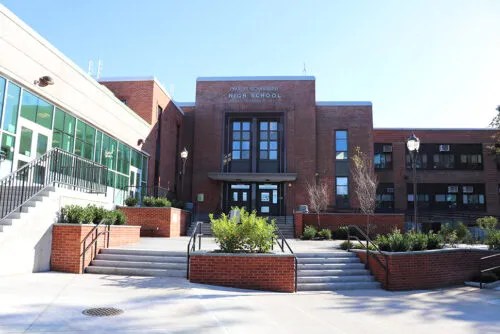
The lawn in front of St. Peter’s School has been transformed over the past few years into a living classroom. It’s been a labor of love by volunteer Beth Ricciardi. Ricciardi volunteers her time tirelessly and with great passion and determination to make a living landscape that’s both educational and beautiful.
Ricciardi has four children: one in Schreiber, one in Weber and two in St. Peter’s. She and her family have lived in Port for 13 years. Ricciardi has a Bachelor’s Degree in art history from Princeton University and a Master of Fine Arts in illustration from the School of Visual Arts. “I’ve also taken online courses in gardening from Cornell University,” said Ricciardi. “Cornell has a great horticultural website, as does the EPA.” She began gardening at St. Peter’s five years ago. “I started with one little garden,” said Ricciardi.

Ricciardi doesn’t use any pesticides in the gardens. “Weeds are plants you don’t want. For many people, clover in the lawn is a weed, but it actually acts as a fertilizer for the lawn because it stores nitrogen in its roots. We compost here also and use it as mulch.”
Ricciardi believes learning should be hands on and physical. Ricciardi helped the graduating class of 2014 build the willow dome to leave as a legacy for young students to enjoy. “Willow is a wonderful living sculpture material,” said Ricciardi. “It’s flexible and takes root quickly.”
There are gardens geared specifically to the curriculum of different grades. There is a salad garden, a bird garden, a butterfly garden and a three sisters garden. On the sunny side of the school building there is a garden that imitates what you would find on the prairie, with succulents and dry grasses. Future plans include a rain garden, said Ricciardi. “The bird garden made with the fourth grade attracts birds because we planted what birds need: fruit, seeds, nesting material, shelter, hiding spots, and we attract insects,” said Ricciardi. “The children researched birds in school to determine what to plant. They planted corn, sunflower, safflower and millet for the birds to eat. We basically planted what you find in birdseed. We learn about birds’ different adaptations and the kinds of birds we can find in our backyards.”
 The butterfly garden made with the fifth grade attracts monarchs because Ricciardi planted millweed, and monarchs can eat that. Ricciardi invites critters and crawlers into the gardens as well. “We have some chipmunks,” said Ricciardi. “A healthy garden includes bugs. Birds need insects to feed their young. They can’t feed their babies birdseed. If you spray your yard for insects, you won’t have birds. The children learn about life cycles and the creatures’ different roles in the ecosystem. They also learn about native plants.” The eighth grade wanted to plant something they can leave behind when they graduated this year so they planted a bulb garden of spring-blooming flowers.
The butterfly garden made with the fifth grade attracts monarchs because Ricciardi planted millweed, and monarchs can eat that. Ricciardi invites critters and crawlers into the gardens as well. “We have some chipmunks,” said Ricciardi. “A healthy garden includes bugs. Birds need insects to feed their young. They can’t feed their babies birdseed. If you spray your yard for insects, you won’t have birds. The children learn about life cycles and the creatures’ different roles in the ecosystem. They also learn about native plants.” The eighth grade wanted to plant something they can leave behind when they graduated this year so they planted a bulb garden of spring-blooming flowers.
 Kindergarten has a flower bed, complete with a headboard, footboard and flower quilt. First grade has an underground garden. “It’s easy to see stems, leaves and flowers above the soil, but what’s happening underneath?” said Ricciardi. “The children learned about how plants use roots and underground storage to help themselves, and sometimes help us too.” The second grade worked on a First Communion garden. The children planted daffodils and grape hyacinths that bloomed around the time of their First Communion.
Kindergarten has a flower bed, complete with a headboard, footboard and flower quilt. First grade has an underground garden. “It’s easy to see stems, leaves and flowers above the soil, but what’s happening underneath?” said Ricciardi. “The children learned about how plants use roots and underground storage to help themselves, and sometimes help us too.” The second grade worked on a First Communion garden. The children planted daffodils and grape hyacinths that bloomed around the time of their First Communion.
The third grade made a salad garden. They learn about nutrition by growing plants to eat. In June, they have a salad party to celebrate.
 In front of the outreach center and food pantry there is a garden with fruits and vegetables to benefit people who use the outreach center.
In front of the outreach center and food pantry there is a garden with fruits and vegetables to benefit people who use the outreach center.
Ricciardi has plans to cultivate more of the property around St. Peter’s property. Ricciardi has created a wonderful outdoor classroom for the students of St. Peter’s. She has a vision and executes it spectacularly for the benefit of the community.



































